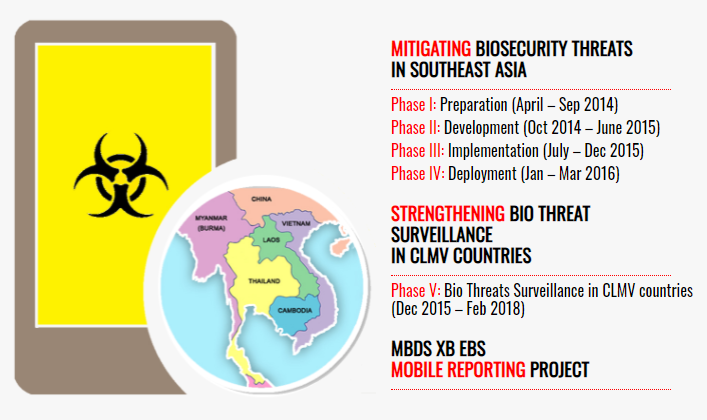ASEAN Biosafety & Biosecurity Network
Enhancing Biosafety, Biosecurity and Bioengineering for Health Laboratories in ASEAN
In 2017 – 2018 as part of the MBT Phase 1, Thailand initiated the project of Biosafety Engineering and Control for Health Laboratories in ASEAN that served as the foundation of key networking activities among ASEAN member states on improving the biosafety and bioengineering within each country and considered as one of the attempts to harmonize biosafety and biosecurity guidelines in ASEAN.
One of the key accomplishments in 2017 – 2018 was the establishment of ASEAN Biosafety Network, this network served as the platform to facilitate exchanges of information, protocols, documents, and pool of experts for future collaborative activities among ASEAN Member States (AMS).
Through this Network, regional gaps and needs was identified for the improvement of Biosafety and Biosecurity, including identification of experts in AMS. With primary focus to enhance the knowledge on Biosafety Cabinet (BSC) in particular on its technology development, maintenance, and certification among ASEAN Member States. BSC is considered as critical component as this equipment serves as the primary containment for controlling biological spread in laboratory.
"The threat from emerging infectious agents and agents of biosecurity concern in ASEAN"
Advances in medical sciences and public health have led to general well-being and longevity of the world population. It was previously expected that the threat from infectious diseases would be finally eliminated. Unfortunately, we now know that this is not going to be true. Changing population demographic profiles and human environment leads to evolving stages of interactions between human and microbes and consequently emerging and reemerging infectious diseases. This is complicated by the possibility of using the biological materials for destruction of life, disruption of food production or scaring the public. South East Asia, including Southern China, is a hot spot of emerging infectious diseases. Multiple factors are implicated including high population densities, intensive animal farming, abundant but rapidly changing ecosystems, lifestyles that promote close contacts between human and wildlife, etc.
The risks are exemplified by several major outbreaks in the last decade such as SARS and avian influenza, which, led to devastating economic impacts. ASEAN is on the verge of becoming a single economic community starting from 2015. In order to fulfill that goal, an extensive road network has been proposed and built. Most have already been finished.
Although not all of them have the same quality, they will definitely allow the transportation of people and goods, in the amount that ASEAN has never witnessed before. It is hoped that this will lead to sharing of prosperity, well-being and the sense of common values. As any good things, the road network can also have an unintentional effect.
It can become a conduit of infectious patients or agents. People infected with a respiratory pathogen in Vietnam can travel by road and still arrive at a port in Myanmar before being sick. Contaminated food can be transported around quickly and consumed almost simultaneously in several destinations. The soil in the region is a natural habitat of Burkholderia pseudomallei, which can cause septicemia, a deadly disease. It can be easily spread around by cars and trucks. Burkholderia pseudomallei and several respiratory pathogens are of biosecurity concerns. Intentional food contamination can severely affect consumer confidence and lead to consequent disruption of food distribution and agricultural production with enormous economic impacts in the regions and globally, as ASEAN is one of the world major food producing areas.

Poster
Biosafety Manual
Biosafety Cabinets
- Biosafety cabinets safe use and operation
- Placement of biosafety cabinets in the laboratory
- Primary containment of biohazards selection installation and use of biological safety cabinets
Biorisk MX Training
- ASEAN regional forum best practices for biorisk management
- ESBA CWA 15793 meeting report
- EU 2013 decision on biorisk management
- Laboratory biorisk management - guidelines for implementation CWA 16393
- Laboratory biorisk management - CWA 15793
- Laboratory biorisk management - CWA 15793 (arabic)
- Laboratory biorisk management - CWA 15793 (russian)
BSL3 Facilities
Related links
-
BIOSAFETY INFORMATION NETWORK AND ADVISORY SERVICE
PROGRAM FOR BIOSAFETY SYSTEM
INSTITUIONAL BIOSAFETY COMMITTEES
BIOSAFETY CLEARING HOUSE
BIOSECUIRTY – DEPARTMENT OF AGRICULTURE AND WATER RESOURCES
UCSD BIOSAFETY PROGRAM
BIOSECUIRTY – PROTECT YOUR ANIMALS AND PLANTS FROM PESTS AND DISEASES ABOUT FARM BIOSECURITY FOR PIGS
ADVANCING THE LABORATORY PROFESSION AND NETWORKS IN AFRICA
Related Documents
- WHA RESOLUTION
- WHO IHR MONITORING FRAMEWROK
- WHA RESOLUTION 55-16 – GLOBAL PUBLIC HEALTH RESPONSE
- WHA RESOLUTION 58-29 – GLOBAL PUBLIC HEALTH RESPONSE
- GAR NATURAL VENTILATION(NATVENT)
- RESPONSIBLE LIEF SCIENCES RESEARCH FOR GLOBAL HEA
MULTIMEDIA
AVIAN INFLUENZA
MELIOIDOSIS
SALMONELLOSIS
PPE











